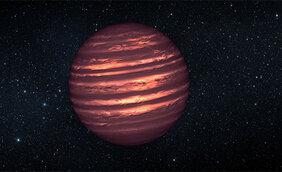Brown dwarfs fill the “gap” between stars and the much smaller planets – two very different types of astronomical objects. But how they originate has yet to be fully explained. Astronomers from Heidelberg University may now be able to answer that question. They discovered that the star v Ophiuchi in the Milky Way is being orbited by two brown dwarfs, which in all probability formed along with the star from a gas and dust disk, just as planets do. The research results were published in “Astronomy & Astrophysics”.
Brown dwarfs orbit either one star or travel in isolation in the vast expanse of the Milky Way. Their mass – they are at least 13 times heavier than the planet Jupiter – is sufficient to generate, at least temporarily, energy in their core through nuclear fusion. They are not sufficiently massive, however, to ignite hydrogen in their cores and hence to create their own light. The heat they continue to radiate after formation is how astronomers are able to locate them. It is estimated that up to 100 billion brown dwarfs make their home in the Milky Way. Yet it remains unclear how they form – whether they are “failed” stars or possibly even super-planets.
The recent discoveries made at the Centre for Astronomy of Heidelberg University (ZAH) could provide an answer. Prof. Dr Andreas Quirrenbach and his team at the Königstuhl State Observatory of the ZAH analysed the variations in radial velocity of the star v Ophiuchi. Using telescopes in the USA and Japan, the Heidelberg astronomers and others measured the velocity of the star for 11 years. The star has a mass slightly greater than two and half times that of the Sun, and is located approximately 150 light years from Earth in the constellation Ophiuchus.
ORIGINAL PUBLICATION
A. Quirrenbach, T. Trifonov, M.H. Lee, S. Reffert: Precise Radial Velocities of Giant Stars. XI. Two Brown Dwarfs in 6:1 mean motion resonance around the K giant star v Ophiuchi. Astronomy & Astrophysics 624, A18 (2019), <link https: doi.org>
doi.org/10.1051/0004-6361/201834423
<link https: www.uni-heidelberg.de presse news2019 pm20190409_are-brown-dwarfs-failed-stars-or-super-planets.html external-link-new-window internal link in current>PRESS RELEASE BY UNIVERSITY OF HEIDELBERG
LOCAL CONTACT
Dr. Guido Thimm
Zentrum für Astronomie der Universität Heidelberg (ZAH)
Email: <link>thimm@uni-heidelberg.de
FURTHER INFORMATION<link http: carmenes.caha.es internal link in current>
Hompage of the CARMENES Consortium

